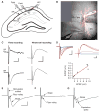Long-Term Potentiation by Theta-Burst Stimulation Using Extracellular Field Potential Recordings in Acute Hippocampal Slices
- PMID: 27250947
- PMCID: PMC5291724
- DOI: 10.1101/pdb.prot091298
Long-Term Potentiation by Theta-Burst Stimulation Using Extracellular Field Potential Recordings in Acute Hippocampal Slices
Abstract
This protocol describes how to carry out theta-burst long-term potentiation (LTP) with extracellular field recordings in acute rodent hippocampal slices. This method is relatively simple and noninvasive and provides a way to sample many neurons simultaneously, making it suitable for applications requiring higher throughput than whole-cell recording.
© 2016 Cold Spring Harbor Laboratory Press.
Figures


References
-
- Abrahamsson T, Gustafsson B, Hanse E. AMPA silencing is a prerequisite for developmental long-term potentiation in the hippocampal CA1 region. J Neurophysiol. 2008;100:2605–2614. - PubMed
-
- Artola A, Bröcher S, Singer W. Different voltage-dependent thresholds for inducing long-term depression and long-term potentiation in slices of rat visual cortex. Nature. 1990;347:69–72. - PubMed
Publication types
MeSH terms
Grants and funding
LinkOut - more resources
Full Text Sources
Other Literature Sources
Medical
